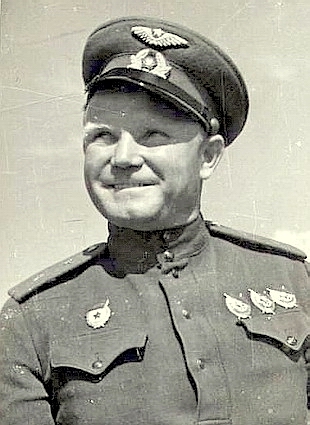Soviet Union

General Major Pavel Pavlovich Kryukov HSU
Soviet Union

General Major Pavel Pavlovich Kryukov HSU

15 December 1906 - 11 November 1974
Kryukov was born on 15 December 1906 in the village of Birevo, near Moscow.
He flew for the first time in 1931 when he flew an R-1 biplane (unlicensed copy of DH-9).
In 1932, he joined the army.
During the summer 1939, he saw action in the 70 IAP equipped with I-15bis against the Japanese over the Khalkhin Gol River in Mongolia.
At 15:00 on 22 June, 22 I-16s and 14 I-15bis scrambled for the area of Khalkhin Gol River estuary and Chychy-Undur-Obo. At 15:42 they became entangled in combat with two groups of Ki-27s. The first enemy formation consisted of 12 fighters and the second of 27. Eight I-15bis were lost in air combat, two I-16s were set alight on the ground and one was shot down. In return the Soviet pilots claimed seven Japanese fighters as shot down. At 17:34 the Japanese pilots broke off the combat and escaped in direction of Gandzur.
At 15:40, twelve I-16s and 14 I-15bis from 22 IAP scrambled and became engaged with Ki-27s. They returned at 17:15 and three I-16s and six I-15bis failed to return. One I-16 and one I-15bis forced-landed in the area of Hill 704. One pilot was found wounded and admitted to the hospital. Starshiy leitenant Anton Blazko was KIA in the Tamsag Bulag area.
At 16:57 twelve more I-15bis and ten more I-16s from 22 IAP took off for the battle area. They saw no enemy planes and returned at 18:10. According to the pilot Golubev one Ki-27 was destroyed on the ground in enemy territory during the first mission.
The Japanese reported that Soviet fighters crossed the border at Amkuro, south-east of Kanjur, and the 2nd chutai of the 24th Sentai took off to intercept, followed by the 1st chutai. The 2nd chutai encountered a reported 60 fighters and in the ensuing combat claimed 18 shot down for the loss of four; including the CO Captain Shigenobu Morimoto (Class 42), Sergeant Major Yoshio Yoshino (NCO67), Sergeant Major Kunizo Ishizuka (NCO73), which all three were killed and Sergeant Major Yotutaka Miyajima (NCO54) who was taken POW. A fifth fighter force-landed and the pilot returned later. Meanwhile, the 1st chutai joined the combat somewhat later, claiming six more victories.
An hour later, there was another alarm and the 1st chutai took off again, engaging ten plus I-15bis and a similar number of I-16s. The 2nd chutai had followed, and at once entered the fight, the 24th Sentai’s units together claiming 25 further victories, this time without loss. It seems that eight probables were also claimed.
During the second engagement, Captain Saiji Kani (leader of the 1st chutai) claimed five victories and later described the combat:
"How many enemy aircraft there were; but we have the courage, like eagles pursuing swallows, and overwhelmed the enemy. About 5.30 pm I spotted 25-26 more flying at about 2,000 metres - on the first pass one was going down in flames, and one by one others went down in the same way - more new enemy aircraft appeared and entered the battle - they were all around - we left the area of fighting and returned. There were many hits in the wings and tail of my aircraft."1st Lieutenant Shoichi Suzuki of the 1st chutai claimed five victories during the day but was hit and wounded in his right wrist. Attempting to head for home, he was chased persistently by three Soviet fighters, so turning on these, he shot down all three to bring his total for the day to eight. He was hospitalized next month after this combat.
For his services during this conflict, he was awarded with the Order of the Red Banner.
According to his own recollections, he claimed three victories against the Japanese, but this is not verified with any operational records.
In June 1941, he was a kapitan leading an eskadrilya of the 55 IAP, flying reconnaissance missions in MiG-3s over the river Prut.
On 22 June, pilots of the 55 IAP were tasked with reconnoitring the enemy. Following orders received from divisional level, a pair of MiG-3s took off on a reconnaissance mission deep into Rumania, over Ploesti. However, neither pilot returned. Not having calculated their fuel reserves correctly, both had to force-land due to fuel shortage. Kryukov, who was flying the MiG-3 only for the second time, was barely able to cross the Danube and made an emergency landing. However, the other pilot, Yakovenko, was not able to reach friendly territory and landed in Rumania. He managed to return to his regiment several days later.
During the autumn, Kryukov commanded a training eskadrilya in the regiment where he together with the ace to be Pokrishkin trained new pilots.
On 7 March 1942, the unit was renamed 16 GIAP. At this time, it was operating on the South-Western Front, and later on the North Caucasus Front.
On 18 May 1942, he claimed a Ju 88.
During the Kuban River operations of early 1943, the unit was re-equipped with P-39 Airacobras. Kryukov was at this time a Major.
On 11 April 1943, he claimed three Bf 109s. this combat was witnessed by general Vershinin who awarded him with a second Order of the Red Banner.
Totally during the Kuban River operations, he flew 50 sorties and claimed 5 victories.
On 24 May 1943, he was awarded with the Gold Star of the Hero of the Soviet Union (# 992) and the Order of Lenin. At this time, he had flown 415 sorties and taken part in 40 air combats.
He continued to lead the regiment on the South East Front, and from the beginning of 1944, on the Ukrainian Front.
In early March 1944, a group of pilots (36 men – 3 squadrons) from the 9 GIAD was dispatched to the Caucasus to pick up and ferry back P-39s, which was arriving by Lend-Lease through Iran. Mayor Kryukov of the 104 GIAP was placed in command of the group.
The aircraft was to be flown from the point of issue to their airfield in Chernigov (approximately 60 miles north-east of Kiev) and Kryukov planned and maintained a route with the fewest possible landings.
On 10 March, the pilots flew in squadron-size sub elements with Kryukov leading the first, kapitan Nikolay Lavitskiy leading the second and Anatoliy Komosa leading the third. The planned flight altitude was 6560 to 9845 feet, depending on ceiling and visibility in any overcast they might encounter. A speed was selected that favoured fuel economy and radio listening silence was to be maintained.
When they approached Gudermes station, Lavitskiy suddenly called Kryukov that his engine was smoking and Kryukov ordered him to land. A few moments later Lavitskiy radioed that his engine now was on fire and his aircraft was seen burning by his squadron comrades. Kryukov again ordered him to land immediately. Lavitskiy wasn’t however able to find any suitable spot to make an emergency landing on and soon his cockpit was full of smoke which made him unable to see the ground. Kryukov now ordered him to bail out but Lavitskiy refused since now he was over the Gudermes station, which was full of men and equipment.
Lavitskiy was able to stretch the glide of his burning aircraft over the station but then began to lose altitude rapidly, went over its left wing and hit the ground at full speed. Lavitskiy was killed instantly.
In July 1944, the whole 9 GIAD transferred to the 2nd Ukrainian Front to take part in the Lvov-Sandomierz campaign.
Kryukov was then promoted to polkovnik given command of the 104 GIAP. He continued to fly until the end of the war on the 1st Ukrainian Front with this unit.
Kryukov ended the war with 11 victories.
These were claimed during 608 combat missions and 62 air combats.
He remained in the VVS after the war and graduated from the General Staff Academy in 1951.
In 1956, he retired as a General Major to live in Moscow.
Kryukov died in Moscow on 11 November 1974.
During his active career, he was decorated the Order the Red Banner (29 August 1939, 22 December 1941, 22 April 1943 and 20 April 1953), the Order of Suvorov 2nd (29 May 1945) and 3rd Class (16 October 1944, the Order of Kutuzov 2nd Class (6 April 1945) and the Order of the Red Star (24 June 1948).
Claims:
| Kill no. | Date | Time | Number | Type | Result | Plane type | Serial no. | Locality | Unit |
| 1942 | |||||||||
| 1 | 27/06/42 | 1 | Bf 109 | Destroyed | MiG-3 | Lisichansk | 16 GIAP | ||
| 27/07/42 | 1/3 | FW 189 | Shared destroyed | MiG-3 | S Novobataysk | 16 GIAP | |||
| 2 | 30/06/42 | 1 | He 111 | Destroyed | MiG-3 | Shkurinskaya | 16 GIAP | ||
| 1943 | |||||||||
| 3 | 11/04/43 | 1 | Bf 109 | Destroyed | Airacobra | Crimea | 16 GIAP | ||
| 4 | 11/04/43 | 1 | Bf 109 | Destroyed | Airacobra | Crimea | 16 GIAP | ||
| 5 | 11/04/43 | 1 | Bf 109 | Destroyed | Airacobra | Crimea | 16 GIAP | ||
| 6 | 15/04/43 | 1 | Ju 88 | Destroyed | Airacobra | S Crimea | 16 GIAP | ||
| 7 | 15/04/43 | 1 | Ju 88 | Destroyed | Airacobra | Kabardinskaya | 16 GIAP | ||
| 8 | 18/05/43 | 1 | Bf 109 | Destroyed | Airacobra | SE Verkhnebakanskaya | 16 GIAP | ||
| 9 | 27/05/43 | 1 | Bf 109 | Destroyed | Airacobra | SW Moldavia | 16 GIAP | ||
| 1944 | |||||||||
| 10 | 31/05/44 | 1 | Ju 88 | Destroyed | Airacobra | Valya-Lunga | 104 GIAP | ||
| 11 | 22/07/44 | 1 | He 111 | Destroyed | Airacobra | N Olenitsa | 104 GIAP |
TOTAL: 11 and 1 shared destroyed.
Sources:
All aces of Stalin 1936–1953 – Mikhail Bykov, 2014
Attack of the Airacobras - Dmitriy Loza, 2002 University Press of Kansas, ISBN 0-7006-1140-1
From Barbarossa to Odessa: Volume 1 – Dénes Bernád, Dmitriy Karlenko and Jean-Louis Roba, 2007 Ian Allan Publishing Ltd, ISBN 978-85780-273-3
Sovetskiye asy - Nikolay Bodrikhin, 1998, kindly provided by Ondrej Repka.
Soviet Aces 1936-1953
Stalin's Eagles - Hans D. Seidl, 1998 Schiffer Publishing, ISBN 0-7643-0476-3
Stalin's Falcons - Tomas Polak and Christhoper Shores, 1999 Grub Street, London, ISBN 1-902304-01-2
Additional information kindly provided by Christer Bergström and Ondrej Repka.


